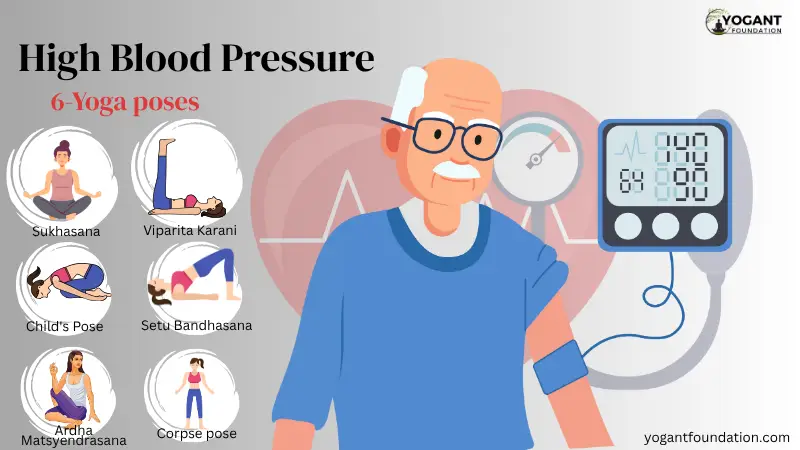Natural Ways to Control High Blood Pressure
Hypertension, or high blood pressure, is one of the most frequent health problems in the world. People sometimes call it the “silent killer.”
While medication helps control the issue, many individuals seek natural, side-effect-free solutions to reduce blood pressure. Yoga is one of the most effective lifestyle adjustments you can make.
This article looks at the 6 – best yoga asana for high blood pressure, using both old wisdom and modern research to back them up.
These poses are good for your heart. They help you relax and improve your blood flow. This is true whether you are new to yoga or just want to rest.
Learning about high blood pressure and how yoga can help
It’s important to know how yoga helps with high blood pressure before you start doing the poses. When the blood pushes too hard against the walls of the arteries, it causes high blood pressure. It can cause heart disease, kidney issues, or stroke over time.
Yoga decreases blood pressure by:
Calming the nervous system
Lowering cortisol levels (the stress hormone)
Improving blood flow
Making the heart stronger
Encouraging deep, diaphragmatic breathing.
Research shows that practicing yoga for 15 to 30 minutes each day can significantly reduce blood pressure. Includes both systolic and diastolic blood pressure.
Before you begin, please read this important note.
Yoga is generally safe. However, you should always talk to your doctor before starting a new fitness program. Especially important if you take medicine for high blood pressure.
1. Deep Breathing in Sukhasana (Easy Pose)
Why It Works:
Sukhasana is a simple cross-legged sitting pose that helps you be peaceful and aware of your breath. It’s great for soothing the nervous system, lowering tension, and getting your body ready for deeper relaxation.
How to Do:
1. Cross your legs and sit on a yoga mat.
2. Relax your shoulders and keep your spine straight.
3. Close your eyes and take deep breaths through your nose.
4. Breathe in for 4 seconds, hold for 4, and breathe out for 6.
5. Keep going for 5 to 10 minutes.
If sitting flat is uncomfortable, put a cushion or yoga block beneath your hips.
2. Child’s Pose (Balasana)
How It Helps:
Balasana is a soothing pose that helps your spine and hips relax. It calms the mind, lowers the heart rate, and activates the parasympathetic nervous system. This system is important for reducing blood pressure.
How to:
1. Get down on your knees and touch your big toes together.
2. Sit back on your heels and bend forward.
3. Put your forehead on the mat and your arms next to your body or stretch them out in front of you.
4. Take deep, steady breaths and hold them for 1 to 3 minutes.
Warning: This posture is not recommended if you are pregnant.
3. Viparita Karani (Legs-Up-The-Wall Pose)
Why It Helps:
This gentle inversion lets blood from the lower body flow back up the heart and brain, which helps with circulation and relaxation. People know that Viparita Karani helps them feel less tired and get more sleep.
1. Sit sideways next to a wall.
2. Lie down and swing your legs up onto the wall.
3. Move your hips close to the wall and let your arms hang by your sides.
4. For 5 to 10 minutes, close your eyes and breathe slowly.
Extra Tip: For extra comfort, put a folded blanket beneath your hips.
4. Setu Bandhasana (Bridge Pose)
How It Helps:
Bridge Pose opens up the chest, extends the spine, and gets the thyroid and heart going. When done gently, it helps blood flow and lowers anxiety, both of which are beneficial for keeping blood pressure in check.
1. Lie on your back with your knees bent and your feet flat on the floor, about hip-width apart.
2. Press feet into the mat and lift your hips upward.
3. Put your arms at your sides or clasp your hands behind your back.
4. Hold it for 30 seconds to 1 minute while breathing normally.
5. Lower down carefully.
Don’t put too much stress on your neck or back. Be gentle with it.
5. Ardha Matsyendrasana (Half Spinal Twist Pose)
Why It Helps: This gentle seated twist massages the kidneys and liver, which are important for keeping blood pressure in check. It also helps the body eliminate toxins and digest food.
1. Sit with your legs straight out in front of you.
2. Bend your right knee and put your foot outside of your left thigh.
3. Bend the left leg or keep it straight.
4. Take a deep breath in, lift your left arm, and then twist to the right and put your hand behind you.
5. Hold for 30 seconds, then switch sides.
Remember to keep your spine long while you twist; never force it.
6. Shavasana, or “corpse pose,” is good for you because
The best way to relax is to do Shavasana at the end of every yoga class. It lets the body process the benefits of the poses and lowers the pulse rate and blood pressure naturally.
How to Do:
1. Lie on your back with your arms at your sides and relaxed.
2. Close your eyes and let your body become completely still.
3. Pay attention to your breathing and make it slow and natural.
4. Hold the pose for 5 to 15 minutes.
Use: Putting a rolled-up towel under your knees will help ease pressure on your lower back.
More Advice for Doing Yoga with High Blood Pressure
Don’t do hard postures like headstands, handstands, or fast-paced vinyasa flows.
Don’t do breath retention (kumbhaka) or intense pranayama like Bhastrika or Kapalabhati unless an expert is guiding you.
Add calming activities like Nadi Shodhana (Alternate Nostril Breathing) and Bhramari Pranayama (Bee Breath) to your daily life.
Drink plenty of water and practice in a calm, quiet place.
Tips for living a healthy lifestyle that will help your yoga practice
Yoga works best when you make changes to your whole life. Here are some ideas:
1. Eat a low-sodium, plant-rich diet (fruits, vegetables, whole grains).
2. Get 7–8 hours of sleep every night.
3. Cut down on how much caffeine and alcohol you drink.
4. Every day, practice meditation and mindfulness.
5. Monitor your blood pressure regularly.
In conclusion, do yoga to keep your heart healthy.
Taking small, steady steps is the first step toward controlling high blood pressure. These 6 yoga poses for high blood pressure are gentle and strong. They can help you relax, restore balance, and improve your health naturally. You don’t have to be an expert or flexible; you just have to care about your health.
Remember to breathe in peace. Let go of stress.
Questions that are asked a lot (FAQs)
Q1: Is it possible for yoga to permanently lower high blood pressure?
Yoga can’t “cure” high blood pressure, but doing it often can lower it a lot. It can also help you rely less on medication, especially if you eat well and exercise.
Q2: How often should I practice yoga for blood pressure?
Aim for 20–30 minutes a day, at least 4–5 days a week. Consistency matters more than intensity.
Q3: Can I do pranayama for high blood pressure?
Yes, but stick to gentle pranayama like Nadi Shodhana and Bhramari. Avoid forceful breathing techniques unless supervised by an expert.
Q4: Is hot yoga good for hypertension?
Hot yoga can increase heart rate and blood pressure, so it’s best avoided unless approved by your healthcare provider.




Thanks for expressing your ideas in this article. The other point is that each time a problem occurs with a pc motherboard, persons should not have some risk regarding repairing the item themselves for if it is not done correctly it can lead to permanent damage to all the laptop. Most commonly it is safe just to approach a dealer of your laptop with the repair of the motherboard. They have technicians with an knowledge in dealing with pc motherboard complications and can make the right prognosis and execute repairs.
Pretty! This has been an incredibly wonderful post. Thank you for providing this information.
Pingback: Triyak tadasana: Hindi Meaning, Benefits & How to do
Thanks , I’ve just been looking for information approximately this topic for a while and yours is the greatest I’ve found out so far. But, what about the conclusion? Are you certain about the supply?